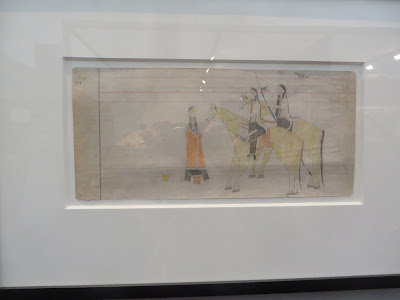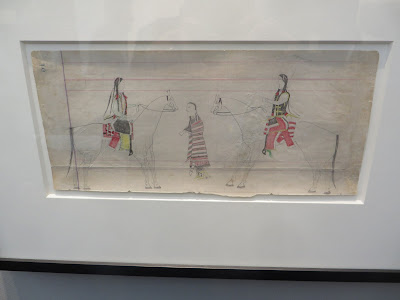A stall at Frieze Masters that I was surprised to enjoy was the one where Sebastian Izzard, a specialist in Asian art from New York, pitched his wares. Until I walked into his little space, the charm of Japanese art had escaped me largely.
It was especially surprising for me that a set of pictures showing cats playing Kabuki roles should be the trigger of my interest. After all, I was exposed to Kabuki on an unusually hot night in Melbourne three or four decades ago, and I didn't become a fan.
The theatre where I had my brush with Kabuki was the one near the Windsor Hotel, now better known for hosting musicals like
Mary Poppins. On the night that I was there - persuaded to go by friends my father liked to describe as "actor cads" - (that is to say, all actors were actor cads to him, not just my particular friends; I think he used this terminology because he had wanted to be an actor and his parents hadn't let him; in fact, possibly that was what they called actors; other times, other et cetera) - the management must have been feeling unusually ambitious. They'd booked a 3-hour long Kabuki performance. For me, it was a profoundly alienating experience. Every minute seemed to endure for lifetimes and yet, while I found it quite astonishingly tedious, everyone else in the audience was in raptures. As we all left the ampitheatre, the air was abuzz with conversations about how what we had all just witnessed was one of the great theatrical experiences of the decade.
I was the lonely dolt, (such experiences, rare though they may be, explain why, while I find Hermann Koch rather chilling, this excerpt from his last novel to be translated into English rang a very recognisable bell with me:
"It was the first time I'd been invited to a Shakespeare production. I'd already seen about ten of his plays. A version of The Taming of the Shrew in which all the male roles were played by women; the Merchant of Venice with the actors in nappies and the actresses wearing rubbish bags for dresses and shopping bags on their heads; Hamlet with an all-Down's-Syndrome cast, wind machines and a (dead) goose that was decapitated on stage, King Lear with Zimbabwean orphans and ex-junkies; Romeo and Juliet in the never-completed tunnel of a subway line, with concentration camp photos projected on the walls, down which sewage trickled; Macbeth in which all the female roles were played by naked men - the only clothing they wore was a thong between their buttocks, with handcuffs and weights hanging form their nipples, performing against a soundtrack consisting of artillery barrages, Radiohead songs and poems by Radovan Karadzic. Besides the fact that you didn't dare to look at how the handcuffs and weights were attached to (or through) the nipples, the problem once again was a matter of how slowly the time passed. I can remember delays at airports that must have lasted half a day, easily, but which were over ten times as quickly as any of those plays.")
Anyway, enough waffle. The pictures that first caught my eye in the Izzard booth were these - the second of them, the man in charge explained, is a famous Romeo and Juliet Kabuki equivalent. They are made by printing and then hand colouring, so far as I could understand:
 |
| Utagawa Kuniyoshi, Cats performing the scolding by torture scene, 1847, Fashionable Feline Follies |
 |
| Utagawa Kuniyoshi, Cats performing in the elopement scene, 1847, Fashionable Feline Follies |
 |
| Utagawa Kuniyoshi, Cats performing in the Kagamiyana Zori Haji scene, 1847, Fashionable Feline Follies |
 |
| Utagawa Kuniyoshi, 1847, Cats performing as the tragic lovers Oshun & Denbei, Fashionable Feline Follies |
Charming, I thought and then I turned and my eye fell on the object that really changed my feeling about Japanese art.
It is a great pity that the object in question carries a price tag of $US350.000. It is an even greater pity that I don't have $US350,000. Here it is:
It is a screen that was made by an unknown artist some time between 1600 and 1620. It depicts six tea-storage jars and six floral arrangements. The jars, I was told, represent the transition from the opulence of the Momoyama period to the rustic aesthetic of the early Edo. I think the flower arrangements may reflect similar historical stylistic shifts. What I loved was the images, the way they were placed in space, the way that if you looked down the screen in one direction you saw only the jars while if you looked from the other direction you saw only the flowers. Actually what I loved was the thing's beauty and the way it conveyed quietness - at least it did to me.
The gallery very kindly supplied me with a tiny picture of the screen, printed on shiny board. I have folded this back and forth so it mimics in miniature its original. If I put my head on the desk and squint at it, I can almost imagine I'm in the presence of the real thing. It's not enough, but it's something:





















































